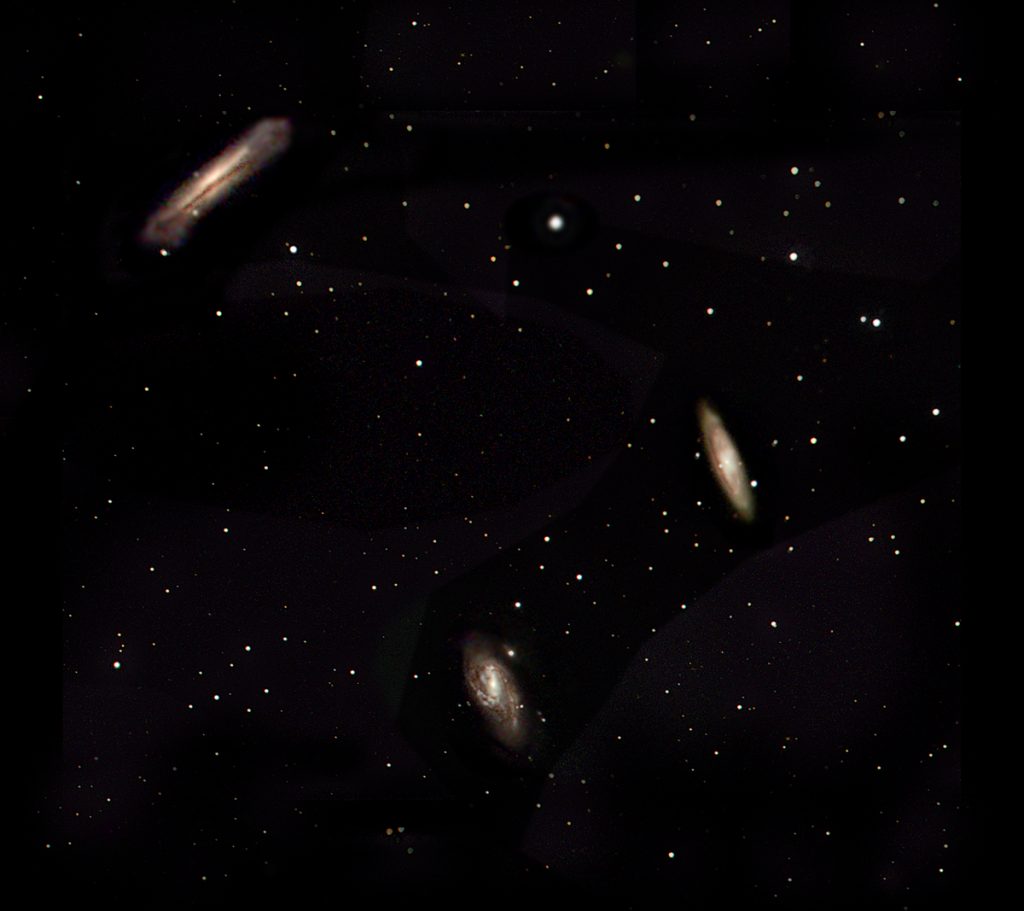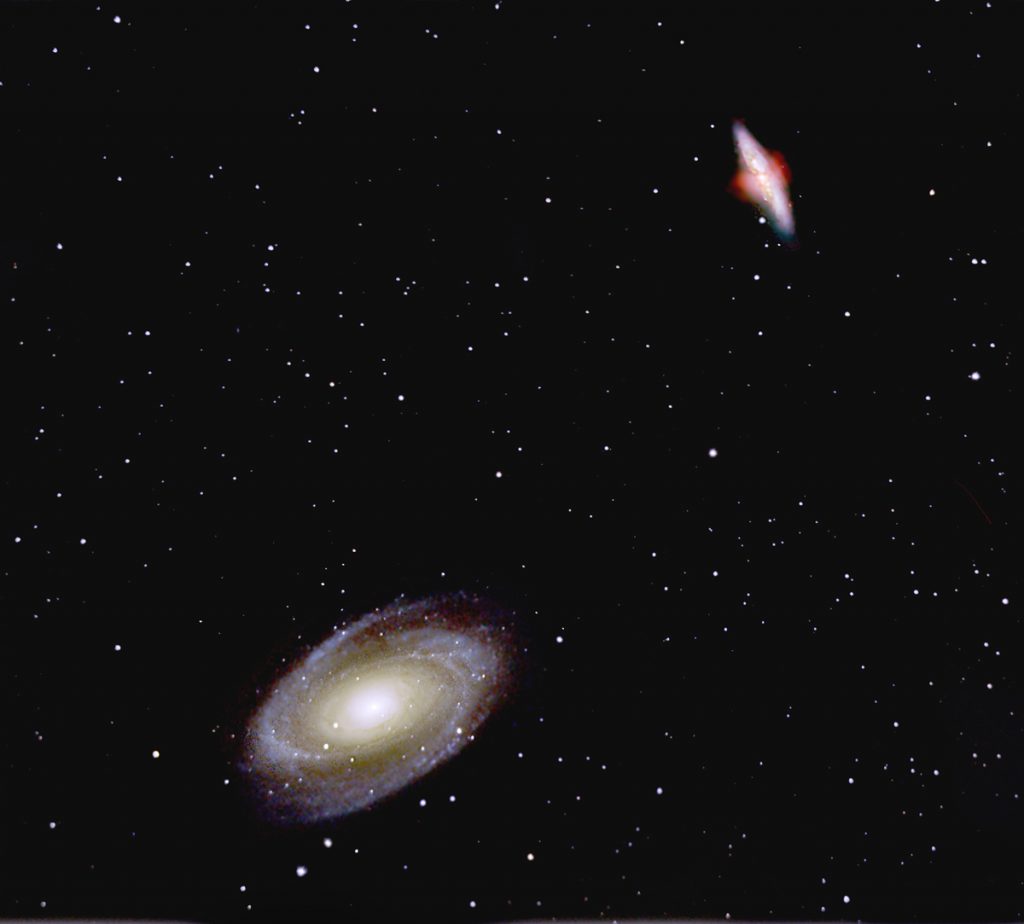OCTOBER 2022
Choosing the sensor size of a deep sky imaging astro camera
Introduction to CMOSastro cameras
As ones interest in deep sky imaging increases, it may well become time to consider the purchase of a dedicated astro camera. The latest which use back-illuminated CMOS sensors are very sensitive and have a very low read noise. Usually equipped with USB3 interfaces, their data can be uploaded very quickly. Together, this means that the effect of a single long exposure of, say, 60 minutes can be obtained by the taking of very many short exposures, perhaps just 30 seconds in length. If a mount is well polar aligned, this can mean that autoguiding is not required except for very long focal length telescopes. As a large number of frames will then have been taken, programs such as Deep Sky Stacker can use the Sigma-Kappa averaging method to eliminate satellite trails. The great thing is that now, particularly if one is using an RGB colour camera, astroimaging can be a far simpler process than in the past.
Though these cameras can be obtained with fan cooling, I dothink it is worth paying more to acquire one which is Peltier cooled as thecamera’s dark current when cooled to, say, -15 C is so low that it may bemasked by light pollution and so there is less need for dark frames. Dark frames were not used in the processing ofany of the images shown below. (I doimage under a class 5 Bortle sky where the sky glow masks the dark current, butdark frames may well become useful under really dark skies. The fact that the sensor’s temperature, ifPeltier cooled, can be set means that itbecomes easy to take a set of dark frames at the same exposure as the ‘light’frames whenever it is convenient. If so,there is no need to take any bias frames.)
One very useful aspect is that, somewhat to my surprise,they can be used as very competent ‘webcams’ for lunar or planetaryimaging. Using SharpCap Pro, the area ofthe sensor used can be reduced to, perhaps just 800 x 600 pixels, so uploadspeeds can be very fast. I have obtained~40 frames per second when used with a i5 laptop and external SSD hard drive onwhich to store the captured frames. Aninteresting use when imaging Jupiter is that, using the full sensor size, thecamera can (at a slow frame rate) image both Jupiter and its moons beforereducing the sensor size to capture Jupiter. This has another advantage; having found a planet using full frameimages, one centres it in the frame andthen reduce the frame size whilst each time bringing it to the centre of theframe. In the past we had to use ‘flipmirrors’ to enable the planetary image to be centred on the very small webcam sensor.

Camera Sensor sizes
CMOS astro cameras for deep sky imaging can be acquired withsensors having sizes from 1 inch, through Micro 4/3 and APS-C to Full Frame. As one would expect, the cost goes up as thesensor size is increased.

If money were no object one might choose a full frame sensor camera – but its use may run into problems. With many telescopes the image circle of sharp, unvignetted stars may well not cover a full frame sensor unless the telescope, termed an astrograph, is specifically designed to do so. I do have one quadruplet refractor astrograph and even this shows some mild vignetting in the corners of a full frame. So to make full use of a full frame sensor one need to purchase expensive telescopes or field correctors and, until one is a very advances imager, I would not recommend buying one. For example, the Celestron Edge HD Schmidt-Cassegrain varients can just cover a full frame sensor, but only an APS-C sized sensor when used with their focal reducers.
I also suspect that it would be worth acquiring either a Micro 4/3 or APS-C sensor camera rather than a 1 inch sensor camera. The Altair Astro Hypercam 294C PRO TEC camera at £899 is less expensive than the ZWO 1 inch camera and comes with a hard case and 12 volt power supply for the Peltier cooling system.
But which, Micro 4/3 or APS-C?
The Micro 4/3 sensor has a squarer sensor than an APS-Csensor but its height is not that much less (80 % that of an APS-C sensor). A slightly shorter focal length telescopewould be required to give the same field height. I have been using a Micro 4/3 sensor camerafor a couple of years now and have never felt the need for an APS-C sizedsensor. The reason is simple. Most deep sky objects, such as globularclusters, planetary nebula and many galaxies, will fit into a square format sothat, in the majority of cases, the extra width of the APS-C sensor does notreally gain much.
My advice is thus to acquire, as I did, a camera with a Micro 4/3 sensor such as the Altair Astro 294mc colour camera which is significantly less expensive than the (essentially identical) ZWO version. One possible downside is that it cannot be used with the ZWO ASI Air system that many are now using for their image capture. Though perhaps less neat, I am using SharpCap Pro on a laptop to control the camera and mount to achieve essentially the same results (such as polar alignment, plate solving and live stacking).
[Note: I was a bit surprised when Astrometry.net gave me slightly larger fields of view than I had calculated using the standard 17.3 x 13 mm Micro 4/3 sensor size. The reason is simply that the sensor in the 294 cameras actually have a size of 19.1 x 13 mm so are actually 10% larger in size. Good.]
Some examples using the Altair Astro Hypercam294C PRO TEC Micro 4/3 camera
In allcases, these images were taken within a mile from the centre of a town withsignificant light pollution. No darks orflat were taken.
Using a Celestron9.25 inch Schmidt-Cassegrain
The Schmidt-Cassegrain telescopes were designed when 1.25 inch eyepieces were the norm and were never intended to provide a wide, unvignetted field of view. [Later versions such as the Celestron Edge HD and Meade ACF telescopes address this problem.] The Celeston 9.25 Edge HD is considerably more expensive than my original version and will certainly cover an APS-C sensor but, as seen in the image below of M27, the Dumbell Nebula, an essentially perfect image is acquired on a Micro 4/3 sensor using the standard telescope. Also shown is a very tight crop of M57 and an image of M13, the globular cluster in Hercules. The combination of standard 8 inch Celestron S-C and Micro 4/3 camera will be significantly less expensive than the 8 inch Edge HD and APS-C camera. [I should point out that Meade now only sell their ACF models at no increase in cost over the standard versions.]



Using a standard 80mm refractor and field flattener to image the Rosette Nebula
The telescope used was an 80 mm OpticStar refractor having a500 mm focal length and employing an FPL-53 doublet objective. A TS-Optics 2 inch field flattener (perhapsthe best there is and which can be used with a wide range of refractors) was inthe optical train some 128 mm from the camera sensor – which is why it performsso well. The image is a composite of anRGB image (for the stars) and an H-alpha image (for the nebula). As the Nebula is circular, an APS-C sensorcamera would not have really added anything.

Using an f/4Newtonian with coma corrector to image galaxies
These are two images of galaxies taken using an 200 mmaperture, 800 mm focal length, Newtonian. Again, the extra width of an APS-C sensor would not have been an asset.


Imaging the Moon witha 820 mm focal length refractor.
The Micro 4/3 sensor is 17.3 x 13.5 mm in size, so coupledwith the 820 mm focal length telescope the sensor subtends an angle of greaterthan 1 degree on the sky so that the full lunar disk is covered – meaning thatonly a single video sequence need be taken. This does, however, produce a very large video file of some gigabytes insize and needs a computer with a large memory to process it!


Imaging the Moon withan 8 inch Ritchey-Chrétien telescope having a 1,625 mm focal length
With such a focal length telescope, though the full lunar disk could not be covered with a Micro 4/3 sensor, a 12 day old Moon was fully covered and so only a single video sequence was needed. As each pixel of the sensor now only subtends 0.6 arc seconds on the lunar surface, it is better sampled than with the 820 mm refractor.

Imaging M31, theAndromeda Galaxy with a short focal length refractor of ~400 mm focal length
I can achieve such a short focal length either by using a dedicated astrograph of 422 mm focal length or a semi-apo 80 mm, f/6.25 refractor used with a Televue x0.8 reducer/flattener giving a focal length of 416 mm. With this focal length, the Micro 4/3 sensor just covers the galaxy but I have to admit that M31 is one object where an APS-C sensor better fits the elongated shape of the galaxy and so longer focal length telescope could be used.
